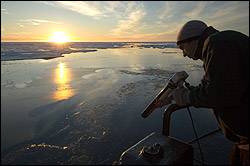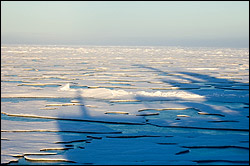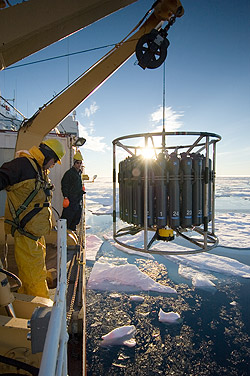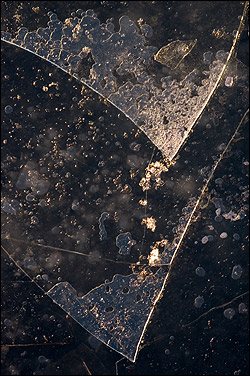Please note: You are viewing
the unstyled version of this website. Either your browser does not support CSS
(cascading style sheets) or it has been disabled. Skip
navigation.
Chris LinderAugust 18, 2005
The sun first appeared late last night. The sight of the orange glow lingering on the horizon was so beautiful that the watch team paged me so I wouldn't miss it. I got dressed just in time to catch Will Burt launching an XCTD off the fantail. The sun was at its lowest point, just grazing the horizon. While holding the XCTD launcher, Will used his other hand to snap photos of the sunset (or was it sunrise by now?). The time was 3:15AM. Since our previous sunny moments have been so brief, I didn't want to miss a single minute of the warm, golden light. So, I put on my warmest clothes and boots and grabbed the camera gear for an all-night vigil. The air temperature was a chilly 27 degrees F. At this latitude, it takes about six hours for the sun to set and rise, although in reality the sun just swings through a shallow arc just above the horizon. By 7:30AM (see CTD photo at right), the sun was already climbing high in the sky. The clear, calm night created a half-inch-thick layer of new sea ice in all of the open leads and melt ponds. Of all the kinds of ice we have seen, I find new ice the most fascinating. Our morning CTD station was in a lead full of this brittle new ice. As the bridge maneuvered the ship, the ice shattered like broken glass and our waves caused the sharp panes to clatter together. The sound of the clattering ice is bizarre--the closest comparison is the metallic twanging sound of laser guns on science fiction movies like Star Wars. While I was catching up on sleep after breakfast, pilot Chris Swannell took John, Rick, and Lucie on a helicopter flight to find a floe for the next ice camp. Since this area is full of multi-year ice, they didn't have a problem picking out several candidates. However, because of the thick ice concentration we have been having a hard time making progress eastward. The floes and pressure ridges are so thick that even with three of the Louis' four engines running full speed ahead, we bounce off the toughest ridges two, three, even four times before breaking through. Chief Scientist Sarah Zimmermann has been glancing at her watch almost more than her computer screen lately. Time is running out for this expedition, and our work is only half done. Given the difficult ice conditions, Sarah is already calculating how we might modify our science plan to make the most of our remaining time. Even with the Canadian Coast Guard's most powerful icebreaker, it may be the Beaufort Sea that decides how much we can accomplish. Last updated: October 7, 2019 | ||||||||||||||||||||||
Copyright ©2007 Woods Hole Oceanographic Institution, All Rights Reserved, Privacy Policy. | ||||||||||||||||||||||






